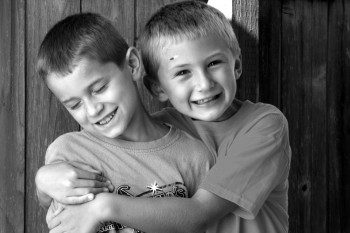News and Notes from The Johnson Center
Teach Your Children About Autism
JCCHD | Sat, April 02, 2016 | [Autism Treatment][Community][Sibling Spotlight]Does your child have a friend who has autism? With 1 in 68 children having an autism diagnosis, the chances are high that your child has encountered or will encounter a peer who has autism at school, extracurricular activities, or community events. People with autism might behave and communicate differently. Here are some tips for helping your kids understand and accept their peers with autism and embrace those differences.

Photo by Stuart Seeger
Demystifying Differences
Being open and honest are keys to reducing the stigma of autism (as well as any other differences). Honest questions aren’t rude, and talking about autism can be done in a way that is educational and supportive rather than judgmental. If a child notices and asks or comments about differences they observe, validate their observation and help them understand. Avoid trying to quiet your child’s questions or encouraging them not to talk about it. When we show we are uncomfortable talking about someone’s different needs or behaviors, it sends the message that being different is shameful. If we can talk openly about it, the topic becomes routine, expected, and no longer something to avoid. Explain to your child that someone with autism may have a different way of communicating. Keep the conversation positive by focusing on what that person is able to do and why their differences are important, rather than stigmatizing them for all of the things they can’t or don’t do or the ways they aren’t the same as you or your child.
Being a Friend
What makes a friend? For most of us, friends are people who share some of our interests and who make us feel good when we’re around them, so we actively seek them out. If someone with autism is a friend to your child, teach them not to let his or her differences get in the way. Encourage your child to accept that differences make us who we are and to embrace these differences in everyone, not just individuals with autism. A great way to normalize this for your child is to model observation and acceptance of differences in your own friend group. Encourage your child to invite their friend to spend time with them, either alone or with a group of other people their age, but to consider their friend’s preferences. Some people might prefer one-on-one play dates or smaller groups, while others have fun with larger crowds. It never hurts (and often helps) to invite the person, regardless of the setting, but keep their needs and preferences in mind. Remind your child that not every friend has the same interests or likes the same things. When your child considers inviting their friend with autism, ask your child to remember anything in the environment that might be difficult for that person. For example, someone who is sensitive to loud noises might not enjoy a loud arcade, and someone with a limited diet might not find much to eat at some restaurants. Of course, your child can always give their friend the information and the choice, but let them know they should not to feel badly if their friend declines for these reasons.
Bullying
Some people with autism are targets for bullying. As a peer, there are things your child can do to help stop it. First, your child can defend the victim. As with any bullying or potentially dangerous situation, if any physical aggression is involved, your child should seek the help of a parent, teacher, or other adult. As much as we want to help a victim of bullying, it’s better that we stay safe by getting help than risk putting ourselves in the middle of danger. If the child with autism is being bullied in a non-physical way, having a peer come to his or her defense is one of the best ways to help. That defense can be standing up for the victim, or it can be as simple as being in the proximity of the victim so that he or she is no longer isolated. Extending an invitation to the victim to go to another location to remove him or her from the situation is another way to help.
Learning to be a friend to someone who seems different is a critical part of growing up. As parents and teachers, we play a huge role in providing information, guidance, and examples to teach our children to be kind, accepting, and supportive friends.



